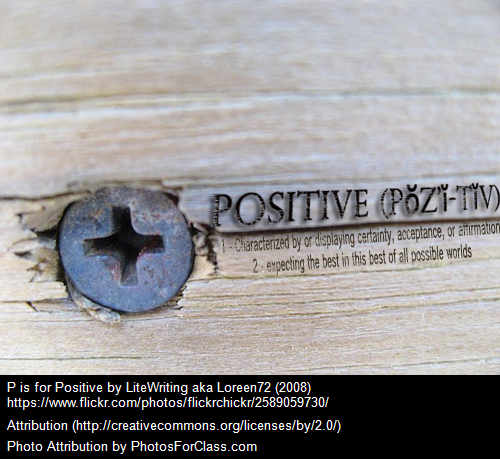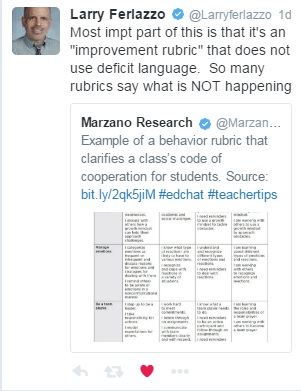We Need to Help ‘Students Recognize the Brilliance They Already Have’ is the headline of my Education Week Teacher five-part series on this very topic!
Looking at our students thought the lens of their assets, not their deficits, has been an underlying them of my teaching career, and I thought I’d bring together many of the posts I’ve written on the topic.
You might also be interested in:
The Best Examples Of Turning Problems Into Opportunities — Help Me Find More
The Best Reasons Why Parents Should Be Looked At As Allies & Not Targets Of Blame
The Best Resources On Students Having A “Purpose For Learning”
Here are posts specifically on looking at the assets of our students:
Video: New TED-Talks PBS Education Show Exceeds My Expectations & Ten Minutes Is A “Must-Watch”
Important New Study Looks At Assets, Not Deficits, Of Teen “Defiance”
Getting Organized Around Assets
A Lesson Highlighting Community Assets — Not Deficits
Very Important New Report On Looking At ELLs Through A Lens Of Assets & Not Deficits
Students Seeing Assets, Not Deficits, In Their Neighborhoods
Response: ‘Respecting Assets That ELLs Bring To A School Community’
Looking For Assets, Not Deficits
Focusing On Neighborhood Assets — One Of My Favorite Lessons!
A Prime Example Of English Language Learner Assets
English-Learners Are Assets, John B. King Jr. Tells Educators in Bilingual Address is from Education Week.
The Positive Impact Of English Language Learners At An Urban School
A Strength-Based Approach to Teaching ESL is from Cult of Pedagogy.
From Deficiency to Strength: Shifting the Mindset about Education Inequality is by Yong Zhao.
The “Genius” Of English Language Learners
I’m adding these two tweets (my first one is commenting on the second one) to this list:
having teachers brainstorm asset-based language they could use with students would be a good exercise for everyone https://t.co/VVnbV0QzXC
— Larry Ferlazzo (@Larryferlazzo) December 1, 2016
@WIDAConsortium Asset-based language lists created by IL educators in a Formative Language Assessment workshop. #wida pic.twitter.com/OfbZAYoJXi
— Amy King (@widakamy) December 1, 2016
Two VERY different views on student thinking. (Thanks, @MathEdnet & @SciEdHenry.) pic.twitter.com/olcLzu8tMi
— Dan Meyer (@ddmeyer) January 11, 2017
Can a Difficult Childhood Enhance Cognition? is from The Atlantic.
Example of a behavior rubric that clarifies a class’s code of cooperation for students. Source: https://t.co/hVVBF7qdch #edchat #teachertips pic.twitter.com/8UxEApgX33
— Marzano Research (@MarzanoResearch) May 20, 2017
The Best Reports On The New “Lost Einsteins” Study
Using Jilk’s (2016) “It was smart when…” statement to name and notice students’ mathematical strengths is from Embracing Life With Major Revisions.
Um… volunteering at a senior living community & this happens. 😳 Who knew?!#RefugeesBringGifts#Assets#Ellchat #TheBigDay@Larryferlazzo @emilyfranESL @MrsSaid17 @SarahOttow @TanELLclassroom @dr_aquagirl @michelleshory @sramirezchess @onerareburger @robinsonjeffery @SBISD pic.twitter.com/mCqsBCl8zk
— Carol Salva (@MsSalvac) February 24, 2018
New Study Finds That Teens Can Learn A New Language As Quickly As Younger Children
Making the Ethical Leap to Strengths-Based IEPs is from Middleweb.
How refugee children make American education stronger is from The Conversation.
A Great Post On Seeing Assets Instead Of Deficits
This NPR video explains one reason why we should be looking at assets:
Did a placement test today for a newcomer from Guatemala. She speaks Spanish and K’iche’ so she is 6 and learning her THIRD language, yet, got upset bc she didn’t understand what I was asking. We need to BUILD UP our multilingual Ss so they KNOW how AWESOME they are! #powerofyet
— Katie Toppel, Ed.D. (@Toppel_ELD) September 7, 2018
WHAT TEACHERS CAN LEARN FROM SERENA WILLIAMS & NAOMI OSAKA
Making Students’ Assets Our #1 Teaching Priority is by Valentina Gonzalez.
10 Ways to Value ELs’ Language Assets is from Tonya Ward Singer.
STEPHEN CURRY WRITES GREAT ARTICLE ON PERSEVERANCE
Gloria Ladson-Billings: Daring to dream in public is from The University of Wisconsin News. There’s a slide in the article titled “Flipping The Question,” which is why I’m adding this resource here.
The Deficit Lens of the ‘Achievement Gap’ Needs to Be Flipped. Here’s How appeared in Education Week.
Many times an EL making an error is actually them telling you how they say it correctly in their L1. https://t.co/ogpCWmvPQc
— Melih Ertekin (@ErtekinELL) July 9, 2019
A LOOK BACK: EMPHASIZING WHAT STUDENTS CAN DO, INSTEAD OF WHAT THEY “CAN’T”
From Deficit-Based to Assets-Based: Breaking Down the Wall One Essential Shift at a Time is by Debbie Zacarian and Diane Staehr Fenner.
3 Steps to Developing an Asset-Based Approach to Teaching is from Edutopia.
Looking Through The Lens Of Assets Works In The Classroom And…In The NBA
Important Article On “Deficit Models” In Education
Unrecognized Strengths is from Character Lab.
Experiences Are Assets: Teachers Can Help Marginalized Students Recognize Their Strengths is from Ed Week.
There’s a lot to think about in The Hechinger Report’s Why we need a proactively anti-racist scientific method.
The Many Benefits of Strengths-Based IEPs is from Edutopia.
Looking at Data Through an Equity Lens comes from ASCD Educational Leadership. I like what the authors say about looking through a “asset-based perspective” lens, which is similar to the “improvement rubric” concept I talk about in some links at The Best Rubric Sites (And A Beginning Discussion About Their Use).
#PairedTexts pic.twitter.com/AJY6bv74Ft
— Jennifer Binis (@JennBinis) February 9, 2022
Good asset approach to teaching voiced by the Ms. Howard character on #AbbottElementary : “Talk about what they do have not what they don’t”
— Larry Ferlazzo (@Larryferlazzo) February 13, 2022
Psychological interventions focused on our strengths may improve mood faster than those focused on weaknesses is from BPS Digest.
3 ways to activate your multilingual students’ superpowers is from Teach Learn Grow.
I Am My Language is from Language Magazine.
“Meeting them where they are” doesn’t mean lowering the bar…I’m tired of hearing this. It means catalyzing, then validating, then amplifying the cultural and intellectual assets that young people already possess before even entering the classroom. #Ratchetdemic
— Adam Calus, M.M.Ed. (@adamcalus_) July 16, 2022
IMMIGRANT STUDENTS’ ASSETS, STRENGTHS, AND CHALLENGES is from Re-Imagining Migration.
These photos can also remind us teachers to see our students through the lens of their assets, and not their ‘deficits’ https://t.co/FkUBN3k0K2
— Larry Ferlazzo (@Larryferlazzo) October 31, 2022
When Confronting Poverty, Think Abundance, Not Scarcity is from ASCD.
For all teachers interested in learning about teaching multilingual learners from an asset-based mindset, take a look at this short white paper published by Alyssa Thornley (@TransACT_K12) @NAELPAforELs @WIDA_UW https://t.co/7xBhqexfRj pic.twitter.com/mcbDRJYrrh
— Cristian R. Medina (@TeacherDrMedina) December 4, 2022
NEW HELPFUL – & PRACTICAL – STUDY ON “ASSET-BASED PEDAGOGY”
How can we best serve multilingual students and plan for their success? In this Peers and Pedagogy post, @growinglearners and @xatlistox discuss changes in terminology and strategy to leverage students’ language assets. https://t.co/qB4Ml9JKjz #teacherchat pic.twitter.com/OC5f51w3wL
— achievethecore.org (@achievethecore) March 24, 2023
What Community Cultural Wealth exists in the communities you serve? Realizing the [non-monetary] assets is part of the foundation of great work and equity. Belief is rooted in seeing the humanity and assets of others. https://t.co/ZCuOIXGjO4 pic.twitter.com/jPzAVe1zJJ
— Crystal M. Watson (@_CrystalMWatson) April 4, 2023
Going from “…’How can we help you? to ‘How can we learn from you to better to make our school community a celebration of all of us?'”- @carli_thomas21 Mic drop! 🎤 https://t.co/mSyeNUKHHy
— Dr. Carol Salva (@DrCarolSalva) June 9, 2023
What Does Equity Really Mean for Multilingual Learners? https://t.co/9jnChVKjP9 via @ASCD
— Kathy Renfrew (@KRScienceLady) June 30, 2023
What are MLs’ assets? @SherryTeacher listed several here: https://t.co/98qZMyMLMB
— Tan K Huynh (he/his) 🇱🇦🇺🇸🏳️🌈 (@TanKHuynh) July 21, 2023
I LIKE THE NEW SCIENCE OF “POSITIVE CHILDHOOD EXPERIENCES” & THE ROLE EDUCATORS CAN PLAY IN THEM
Want to set an asset-based lens for digging into student data?
1️⃣ Share "Student Writing As Data for Love and Instruction" from leader @NQCLiteracy with your staff: https://t.co/1l866k3DQr
2️⃣ Follow @JCareyReads' lead by posting these questions in a common space. pic.twitter.com/JZ2VRuHkSb
— Principal Project (@PrincipalProj) March 27, 2024





Recent Comments